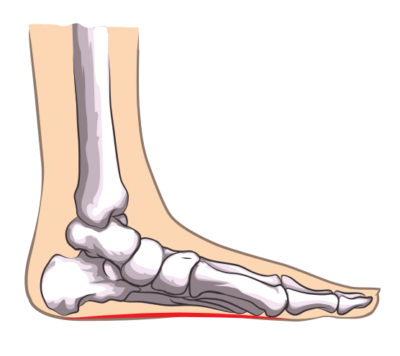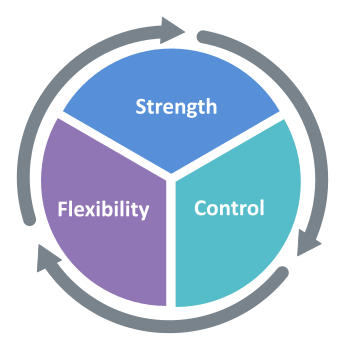The foot is a complex structure. It is made up of 26 bones and many muscles, tendons, and ligaments. The shape of the foot is partly determined by the shapes of the bones and the way those shapes fit together.

There are over 30 connections, called joints, made between the bones of the foot. This high number of joints creates a lot of potential for movement.
Generally speaking, tendons and ligaments determine the amount of movement available at those joints and muscles create the movement.
Flexible Flat Feet
I had an idea when I started out that there was potential for increasing the height of my arches. I’ve always had what is called flexible flat feet. My feet would be flat when standing but there was a small arch present when not standing. If I went up on my toes there was even more of a noticeable arch.
I was fairly sure there was enough motion available in the joints to at least form an arch. So why then were my feet flat when I was standing?
Somewhere along the way, taking into account a number of factors like strength, flexibility, footwear selection and bone structure, the brain and the body got together and decided that my feet were best used as an instrument for standing if they were flat.
It was likely the best available option out of a limited number of options.
I also pronated a lot when I walked or ran. Some amount of pronation is actually a good thing because it’s a natural form of shock absorption. My feet were pronating an excessive amount and I had almost no control over the movement.
Capacity for Change
Before starting the project I had heard stories about people improving their arches. While doing research on this topic I came across fairly convincing evidence that it was possible.
There are also a number of conditions involving the muscles of the foot that can result in the arch height either increasing or decreasing.
So it wasn’t too difficult to imagine that a program of exercises targeting the muscles of the feet might be successful.
My feet were extremely flat though and I didn’t have a clear guide for where to start or what I needed to work on. So it seemed like a daunting task.
But as I exercised more and continued learning, the structure of the program began to take shape.
Program Elements
Because of the complexity of the foot, the program needed to address multiple components. I grouped the different areas that needed to be addressed into three main categories: strength, flexibility, and control.
 Strength
Strength
Strength refers to the amount of force a muscle can produce. There are a number of ways stronger muscles help with forming and stabilizing the arch. For example, strength is needed in the muscles that:
- hold the heel in a neutral position,
- keep the forefoot on the ground to maintain a stable tripod,
- hold the foot stable so that it can be used as an effective lever by the larger muscles of the leg.
A strengthening exercise can be defined as any activity that makes muscles work harder than they’re used to. Many exercises in the program fall into this category. Even though they don’t involve heavy resistance, they require muscles to work in new ways.
Flexibility
Flexibility refers to the elasticity of the muscles and connective tissue that allow motion at a joint. Some examples of where flexibility is needed:
- in the calf muscles that allow the ankle to bend so that the body doesn’t have to compensate with motion in the foot,
- in the joints comprising the middle of the foot to allow the center of the arch to raise,
- with forefoot supinatus, flexibility of the tissue is needed to allow the forefoot to invert on the feet.
A flexibility exercise can be defined as a movement that causes muscles to stretch. The body adapts to repeated stretching over time by increasing flexibility.
Control
Control refers to the ability to use the available strength and flexibility to prevent the arch from collapsing. Control encompasses everything from resting and standing posture of the foot to the movement of the foot with walking.
It’s easy to think of standing as a passive activity. But there is actually a lot going on behind the scenes to keep us upright and balanced. With dynamic activities like walking the demands are even greater.
Complementary Elements
I like to think of these elements complementing each other. So developing strength assists with improving flexibility. Developing control during walking can be used to build strength, and so on.
Thinking about the individual elements was helpful for determining where changes needed to be made. But thinking about how they worked together played a big role in choosing which exercises or activities to perform.
Building the Program
A major influence on my decision to start working on my arches was the research and anecdotal evidence surrounding the barefoot running trend. For a long time, I had thought of my feet as flawed structures that needed support to function properly. Gradually my perspective changed to where I began to see going barefoot (in certain circumstance) as the optimal condition for the foot.
Early on, I even attempted barefoot running–first on sand at the beach and a few times on the road. I think there may have been some benefit if I stuck with it but it wasn’t very practical for me to go to the beach several times a week and I didn’t particularly enjoy barefoot road running. I did try to include as much barefoot activity as possible though.
But the differences in the way the foot functions when running barefoot compared to running with shoes gave me some ideas on what types of exercises I should be working on.
Another source of inspiration came from texts dating back to the WWI era, when soldiers attended special camps to perform exercises to correct their flat feet. Many of these exercises I found valuable and incorporated into my program.
In total, I experimented with lots of exercises for flat feet. There were many that I tried but only for a few sessions. I removed exercises that were too similar to other exercises that I liked doing better or that I couldn’t see a clear benefit in continuing.
I also came up with a lot of variations so that if an exercise was especially challenging I could work on an easier variation and, conversely, if something was getting too easy I could progress it to something more difficult.
More than Exercise
My goal at the onset of this project was to develop arches. I wanted my feet to look the way I thought feet should look. It wasn’t just the shape of the foot that mattered, but even more so it was the function of the foot that I wanted to improve. The main purpose for building arches was so that I could have strong and mobile feet for daily life.
To achieve this, the program expanded beyond what I would consider typical exercise to address posture and habitual movement patterns. Changing my walking mechanics, for example, by paying attention to what my feet were doing with each step played a big role in my success. And these were things that could be practiced just about anywhere.
So it’s been quite a journey, from starting out with a sea of possibilities but with no clear direction to having a program with structure and purpose. It goes back to taking the three basic elements mentioned earlier (strength, flexibility, and control) and applying them to everyday activities ultimately led to the outcome I was looking for.